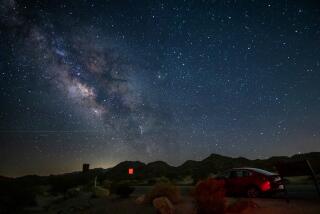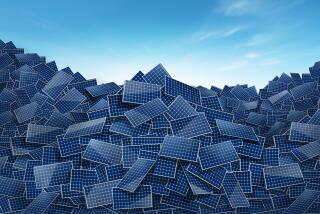Unrecycled new light bulbs release mercury into the environment
- Share via
Reporting from Walnut Creek, Calif. — The nation’s accelerating shift from incandescent lighting to a new generation of energy-efficient bulbs is raising an environmental concern: the release of tons of mercury every year.
The most popular new bulb — the compact fluorescent light bulb, or CFL — accounts for a quarter of new bulb sales. Each contains up to 5 milligrams of mercury, a potent neurotoxin that’s on the worst-offending list of environmental contaminants.
Demand for CFL bulbs is growing as government mandates for energy-efficient lighting take effect, yet only about 2% of residential consumers and one-third of businesses recycle the new bulbs, according to the Assn. of Lighting and Mercury Recyclers.
As a result, U.S. landfills are releasing more than 4 tons of mercury annually into the atmosphere and storm water runoff, according to a study in the Journal of the Air and Waste Management Assn.
A San Francisco hardware store owner is all too familiar with the bulb issue.
“They’re promoting them and giving them away, but there’s nowhere to drop them off,” said Tom Tognetti, co-owner of Fredricksen’s Hardware.
The federal Clean Energy Act of 2007 established energy-efficiency standards for light bulbs that dimmed the future for old-fashioned incandescents, which don’t meet those standards. Incandescents are to be phased out by 2014 in the U.S., and California passed even stricter rules, calling for store shelves to be cleared of them by 2013.
The old-style bulbs are just too wasteful, converting to light only 10% of the energy they consume. The rest is squandered as heat.
Sales of energy-efficient alternatives like CFLs, halogen bulbs and LEDs have been growing steadily, with the low-cost CFLs the biggest sellers.
If every California household replaced five incandescent bulbs with CFLs, the move would save 6.18 billion kilowatt-hours and prevent the annual release of 2.26 million tons of heat-trapping carbon dioxide, according to the California Energy Commission. That’s equivalent to taking 414,000 cars off the road.
But no federal law mandates recycling of household fluorescent lights. Federal rules exempt some businesses, based in part on the number of bulbs used, said Paul Abernathy, executive director of the Napa, Calif.-based recycling association.
Several states, including California, Massachusetts, Maine, Vermont and Minnesota, do require that all households and businesses recycle fluorescents. Abernathy’s group thinks compliance is low because of a lack of convenient drop-off options.
Tognetti’s store is part of a pilot project run by San Francisco to increase recycling of fluorescent bulbs and other hazardous waste. Since 2009, a city-financed truck has regularly stopped by his store and about a dozen other independently owned hardware stores to pick up consumers’ toxic discards.
The National Electrical Manufacturers Assn. in Rosslyn, Va., offers information on fluorescent light bulb recycling at https://www.lamprecycle.org. Home Depot, Ikea, Lowe’s and many Ace Hardware stores, among other outlets, offer free recycling, even for noncustomers.
The website Earth911.com provides a list of recyclers by ZIP Code; or consumers can call 800-CLEAN-UP (253-2687).
CFL bulbs actually have fewer mercury concerns than incandescent lights, according to the California Energy Commission. Although the older bulbs contain no mercury, they’re often powered by coal-fired electricity plants, which release mercury as a pollutant. The result is about 40% less mercury emissions per bulb with CFLs, according to Environmental Protection Agency figures.
But CFLs aren’t the only energy-efficient alternatives to incandescents, said Brad Paulsen, national lighting merchant with Home Depot Inc.
“You really have three options,” he said. “Halogens, LEDs [light-emitting diodes] and CFLs.”
Halogen bulbs are essentially energy-efficient incandescents. “They’re very similar to a person’s experience with incandescents,” Paulsen said, and are 30% more efficient.
Paulsen, along with many others, sees LEDs taking center stage in coming years. The lights contain no mercury, are 85% more energy-efficient than incandescent bulbs, and burn for 25 years.
The main drawback now with LEDs is cost — sometimes $30 or more per bulb — but Paulsen says prices are sure to plunge as demand and production grow.
“LEDs, in my mind, are the way of the future,” he said.
Bohan writes for the Contra Costa Times.
More to Read
Inside the business of entertainment
The Wide Shot brings you news, analysis and insights on everything from streaming wars to production — and what it all means for the future.
You may occasionally receive promotional content from the Los Angeles Times.










